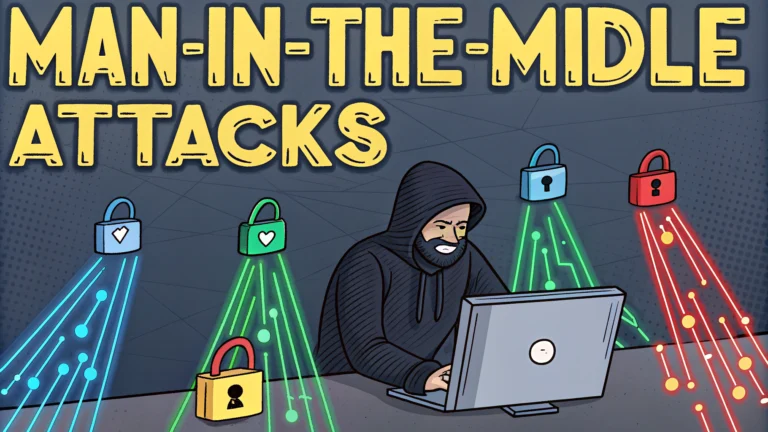A Man-in-the-Middle (MITM) attack occurs when an attacker secretly intercepts and relays messages between two parties who believe they are communicating directly with each other.
Common MITM Attack Types
- ARP Spoofing: Attacker links their MAC address with a legitimate IP address
- DNS Spoofing: Redirects traffic by manipulating DNS records
- SSL/TLS Hijacking: Intercepts HTTPS connections using fake certificates
- Evil Twin: Creates fake WiFi access points mimicking legitimate networks
- Session Hijacking: Steals session cookies to impersonate legitimate users
Tools for MITM Testing
- Wireshark – Network protocol analyzer (Download)
- Ettercap – Comprehensive MITM testing suite (Download)
- Bettercap – Modern MITM framework (Download)
- SSLstrip – HTTPS downgrade attacks
Detection and Prevention
Network administrators should implement proper certificate validation and use tools like Wireshark to monitor for unusual traffic patterns.
- Enable HTTPS Strict Transport Security (HSTS)
- Use Virtual Private Networks (VPNs)
- Implement DNS Security Extensions (DNSSEC)
- Deploy Public Key Pinning
- Monitor network traffic for anomalies
Testing Methodology
- Obtain proper authorization and scope
- Set up monitoring tools
- Execute selected MITM techniques
- Document findings
- Verify impact
- Clean up and restore systems
Legal Considerations
Testing for MITM vulnerabilities requires explicit permission from system owners and compliance with local laws.
| Risk Level | Required Permissions |
|---|---|
| Low | Network Owner Authorization |
| Medium | Network Owner + System Admin |
| High | Written Legal Authorization |
Additional Resources
Report security incidents to US-CERT at https://us-cert.cisa.gov/ or contact your local CERT team.
Impact Assessment
MITM attacks can have severe consequences for organizations and individuals:
- Data theft and credential compromise
- Financial losses through intercepted transactions
- Privacy violations and confidentiality breaches
- Reputation damage and loss of customer trust
- Regulatory compliance violations
Incident Response
Immediate Actions
- Isolate affected systems
- Document all observed anomalies
- Preserve forensic evidence
- Notify relevant stakeholders
- Engage incident response team
Recovery Steps
- Reset compromised credentials
- Revoke and reissue certificates
- Patch vulnerable systems
- Strengthen network segmentation
- Update security policies
Emerging Threats
New MITM attack vectors continue to evolve with technology:
- IoT device exploitation
- 5G network vulnerabilities
- Cloud service interception
- Quantum computing threats
Conclusion
MITM attacks remain a significant threat to network security. Organizations must maintain vigilance through:
- Regular security assessments
- Updated protection measures
- Employee security awareness
- Incident response readiness
Successful MITM defense requires a combination of technical controls, monitoring systems, and human expertise working in concert to detect and prevent attacks.
FAQs
- What is a Man-in-the-Middle (MITM) attack?
A Man-in-the-Middle attack occurs when an attacker secretly intercepts and relays communications between two parties who believe they are directly communicating with each other. - What are the common tools used for MITM penetration testing?
Common tools include Wireshark, Ettercap, Bettercap, Burp Suite, ARP Spoof, SSLstrip, and dsniff. - How does ARP spoofing work in MITM attacks?
ARP spoofing involves sending falsified Address Resolution Protocol messages over a network, linking an attacker’s MAC address with the IP address of a legitimate system, allowing interception of data packets. - What preventive measures can protect against MITM attacks?
Key preventive measures include using strong encryption protocols (TLS/SSL), implementing certificate pinning, enabling HTTPS, using VPNs, and employing mutual authentication. - What are the signs that a MITM attack is occurring?
Signs include unusual certificate warnings, slow network performance, unexpected disconnections, suspicious browser warnings, and unexpected changes in network connectivity. - How do SSL/TLS certificates help prevent MITM attacks?
SSL/TLS certificates establish encrypted connections and verify server authenticity through digital signatures, making it difficult for attackers to intercept communications. - What is SSL stripping and how does it work?
SSL stripping is an attack where HTTPS connections are downgraded to HTTP, allowing attackers to view unencrypted data by intercepting the initial HTTP connection before it’s upgraded to HTTPS. - What network protocols are most vulnerable to MITM attacks?
HTTP, FTP, SMTP, and Telnet are particularly vulnerable due to their unencrypted nature. Legacy protocols without built-in encryption are also at high risk. - How can organizations test their resilience against MITM attacks?
Organizations can conduct regular penetration testing, vulnerability assessments, network monitoring, and security audits using authorized MITM testing tools. - What role does DNS spoofing play in MITM attacks?
DNS spoofing redirects users to malicious websites by corrupting Domain Name System data, allowing attackers to intercept traffic meant for legitimate websites.








